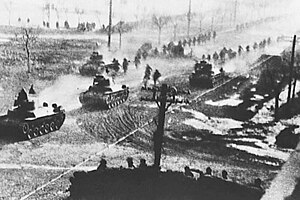Liaoshen campaign
| Liaoshen Campaign | |||||||||
|---|---|---|---|---|---|---|---|---|---|
| Part of the Chinese Civil War | |||||||||
 People's Liberation Army and Type 97 Chi-Ha tanks advance into Shenyang. | |||||||||
| |||||||||
| Belligerents | |||||||||
| Commanders and leaders | |||||||||
|
|
| ||||||||
| Strength | |||||||||
| 550,000 | 700,000 | ||||||||
| Casualties and losses | |||||||||
| ~472,000 (including non-combat losses) | 70,000 | ||||||||
The Liaoshen Campaign (simplified Chinese: 辽沈战役; traditional Chinese: 遼瀋戰役; pinyin: Líaoshên Zhànyì), the abbreviation of Liaoning-Shenyang Campaign, was the first of the three major campaigns (along with Huaihai Campaign and Pingjin Campaign) launched by the People's Liberation Army (PLA) during the late stage of the Chinese Civil War. This engagement is known in the Nationalist Government as the Battle of Liaohsi (Traditional Chinese: 遼西會戰). It took place between September and November 1948 and lasted a total of 52 days. The campaign concluded as PLA defeated the Nationalist forces in Shenyang, Changchun and Jinzhou, capturing all of Manchuria.
Background
After the winter offensive of 1947 in Manchuria, the PLA had expanded into 13 infantry armies, one artillery army, 15 independent divisions as well as 3 cavalry divisions, approximately 54 divisions consisting of over 700,000 men in a field army. The Communist forces also had approximately 300,000 irregulars, effectively controlling 97% percent of the land and 86% of the population in Manchuria by August 1948. While the Nationalist government still had a strength of 44 divisions, a total of 550,000 men including the police force, the PLA had reached numerical superiority.
The Nationalist forces were isolated in Shenyang, Changchun and Jinzhou, none of which were connected to each other. In addition, the PLA had control of Jingha Railway, cutting off the supply line to Shenyang and Changchun. Since the supplies had to be airlifted with enormous difficulties, the Nationalist government were prepared to retreat from Changchun and Shenyang and withdraw to Jinzhou when necessary to prevent the PLA forces in Manchuria from entering Shanhai Pass.
Communist advance (12 September – 20 October)
Jinzhou
On 12 September 1948, the PLA launched a series of attacks along the Jingha Railway and captured Suizhong, Changli, Tashan and Yixian, controlling the area between Jinzhou and Qinhuangdao.
Chiang Kai-shek arrived in Beijing on 30 September and assembled the 39th, 62nd and 92nd Army led by Hou Jingru to reinforce Jinzhou from Huludao. On 2 October, Chiang arrived in Shenyang and ordered Liao Yaoxiang and the 9th Army to reinforce Jinzhou from the west to break the encirclement on Jinzhou.
By 3 October, the Communist forces have assembled 250,000 men and began to encircle Jinzhou. Between 10 and 15 October, the Nationalist forces attempted to reinforce Jinzhou but were stopped in Tashan.
On 14 October, the Communist forces launched the final assault on Jinzhou. The city was captured in the next evening, along with Nationalist commander Fan Hanjie and 80,000 troops.
Changchun
Changchun had been encircled for more than five months prior to the campaign. Already weakened by starvation, the Nationalist garrison were unable to break out of the city despite of the order from Chiang Kai-shek. With the fall of Jinzhou, the 60th Army defected on 17 October, and the New 7th Army surrendered on 19 October.
The remaining Nationalist forces surrendered on 21 October, and the Communist forces had captured Changchun.
Nationalist counter-offensive (21 October – 28 October)
Heishan
After the Nationalist forces suffered heavy losses in Jinzhou and Changchun, Chiang Kai-shek intended to stage a counteroffensive and ordered Liao Yaoxiang and the 9th Army Group to recapture Jinzhou. However, Liao and other senior officers contested the decision.
On 16 October, the Nationalist high command reached consensus and decided to capture Heishan and Dahushan instead, and then retreat south to Yingkou. The decision was approved by Chiang, and on 21 October the 9th Army Group launched an attack on Heishan.
The Communist forces successfully defended Heishan and Dahushan, and the Nationalist forces were unable to make any progress. The 9th Army Group were subsequently encircled and defeated as they failed to retreat to Yingkou.
Fall of Shenyang (29 October – 2 November)
The PLA began to encircle Shenyang on 29 October. Facing imminent destruction, Nationalist commander Wei Lihuang left Shenyang on 30 October.
On 1 November, the Communist forces launched the final assault on Shenyang. The Nationalist garrison had surrendered the next day, and the city was captured. That same day, Yingkou fell to the Communist forces. The remaining Nationalist forces were lifted off to Huludao. The Liaoshen Campaign had concluded.
Aftermath
After the fall of Shenyang, the Nationalist forces in Huludao area were evacuated to Tianjin and Shanghai. The PLA now occupied all of Manchuria.
Manchuria was the major source of raw materials and heavy industry for the Nationalist government. The Nationalist forces suffered heavy losses in the defeat, which significantly reduced the military morale. The PLA were numerically superior for the first time since the onset of the war.
See also
Footnotes
References
- 《雪白血红》 張正隆 解放軍出版社 1989年8月 ISBN 7-01-000381-5/ISBN 7-01-000413-7
- 《辽沈战役概述》杜聿明, 文史资料选辑 第二十辑,1961年8月
- 《东北战场与辽沈战役》韩先楚,《辽沈决战》人民出版社
- 《第十二纵队在辽沈战役中》 袁升平,《辽沈决战》人民出版社
- 《辽沈决战》(上、下)人民出版社 ISBN 7-01-000381-5/ISBN 7-01-000413-7
